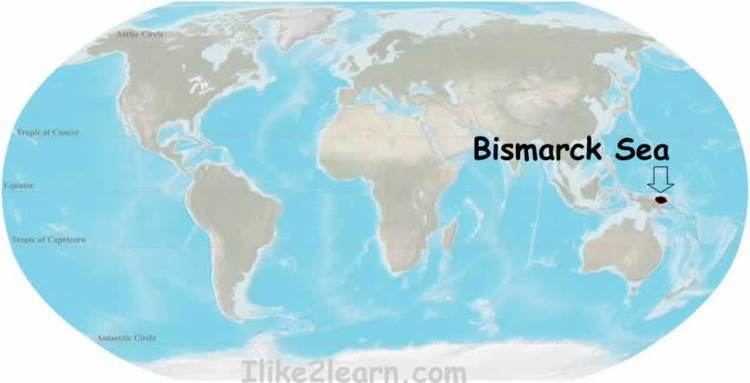Area 40,000 km² | ||
 | ||
Islands Karkar Island, Manam Motu, Sakar Island, Watom Island, Urara Island | ||
Battle of the bismarck sea us australian air raid on japanese ships 1943 ww2 newsreel
The Bismarck Sea lies in the southwestern Pacific Ocean to the north of the island of Papua New Guinea and to the south of the Bismarck Archipelago and Admiralty Islands. Like the Bismarck archipelago, it is named in honour of the German chancellor Otto von Bismarck. The Bismarck archipelago extends round to the east and north of the sea, enclosing the Bismarck Sea and separating it from the Pacific Ocean. To the south it is linked to the Solomon Sea by the Vitiaz Strait.
Contents
- Battle of the bismarck sea us australian air raid on japanese ships 1943 ww2 newsreel
- Map of Bismarck Sea
- Us and aussie aircraft destroy japanese ships in battle of bismarck sea 1943
- Extent
- Mineral wealth
- References
Map of Bismarck Sea
It was the site of a major Japanese naval defeat in the Battle of the Bismarck Sea during World War II on 3 and 4 March 1943.
Us and aussie aircraft destroy japanese ships in battle of bismarck sea 1943
Extent
The International Hydrographic Organization defines the Bismarck Sea as "that area of the South Pacific Ocean off the Northeast coast of New Guinea", with the following limits:
On the North and East. By the Northern and Northeastern coasts of the islands of New Ireland, New Hanover, the Admiralty Islands, Hermit Island, and the Ninigo Group, through Manu and Aua Islands to Wuvulu Island and thence a line to Baudissin Point in New Guinea (142°02'E).
On the Southeast. A line from the Southern point of New Ireland along the parallel of 4°50' South to the coast of New Britain, along its Northern coast and thence a line from its Western extreme through the Northern point of Umboi Island to Teliata Point, New Guinea (5°55′S 147°24′E)
On the Southwest. By the Northeast coast of New Guinea.
Mineral wealth
Recent explorations in the Bismarck Sea seabed have yielded discoveries of mineral-rich beds of sulfides, copper, zinc, silver and gold. These findings are especially important because they lie in shallow, calm waters. Papua New Guinea owns the mining rights to these minerals under international law.
